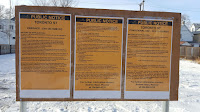© 2020, Christian Cassidy
Toronto Street
I have moaned before about those awful yellow (now orange) public notice posters that are erected when a property needs a conditional use or zoning variance. They're too small, written in legalese, and to find out more about the project you have to track down a city planner by phone or know that there's a DCIM section to the city's website and find a copy of the report there.
This week, I found out a new, troublesome. The city is no longer holding these hearings or posting those hard to find online reports. It's telephone service only!
I noticed some of these posters whilst making some deliveries in my neighbourhood this week. I usually go to the city website and look up the project to see what's happening and because
community housing is one of the hats I wear at work, I also post
something to our social media to say "Hey, Toronto Street residents, new
development going up. Check it out at www.... ")
The reports you get at the DCIM section of the city's website are pretty nonsensical, but in the dozen or more pages you can find at least a few sentences of 'plain speak' and see a site plan or proposed drawing of what is being proposed.
The reports you get at the DCIM section of the city's website are pretty nonsensical, but in the dozen or more pages you can find at least a few sentences of 'plain speak' and see a site plan or proposed drawing of what is being proposed.
Even though the hearings for these was December 15th, I could find no hits when I searched the addresses and file numbers at the city's DCIM website. I contacted a planner to see when they would be posted and was told that there would be no reports issued and there will be no hearing.
The orange signs are now the only information residents get.
The orange signs are now the only information residents get.
Why this big, unannounced change which means that city planners are basically approving these projects on their own without public input?
Since the start of COVID, the Board of Adjustment, which hears zoning matters like conditional use and variances, has not been meeting, so no public hearings. Because there is no hearing, there is no agenda generated for the city's DCIM, so no place to put an online written report about the project.
The only way a report would be made available online is if someone telephoned the city and registered an appeal to one of the projects. That appeal is heard by another committee, which DOES still meet, and a report would be attached to that agenda.
The city must be one of the few organizations in the world that is sharing LESS information online due to COVID.
There is, of course, that telephone number on the poster. This is not a great alternative because:
1. Planners can be hard to get hold of.
2. How can you ask meaningful questions about a project unless you've read a bit about it and have seen a drawing or a site plan?
3. The person you are calling is likely the same one who reviewed the development and stuck their neck out to approve it to their bureaucratic and political masters. They're hardly going to scuttle their own report by saying, "well, there are a couple of downsides ...."
The posters I found around the neighbourhood include one for Toronto Street for an 18-unit apartment block on a residential street that needed three pages to list all the changes it requires. Another is for the knock down of a single family home and erection of a duplex on Beverley Street. The third, posted ten feet above the ground so that no one can read what is being proposed, is on Simcoe Street at Wellington.
The
conclusion is: read these signs very carefully because they are the only
information you will receive about a project in your neighbourhood.
P.S. If you want to read more about what I think of the signs themselves, see this post from back in 2018.
P.S. If you want to read more about what I think of the signs themselves, see this post from back in 2018.




No comments:
Post a Comment